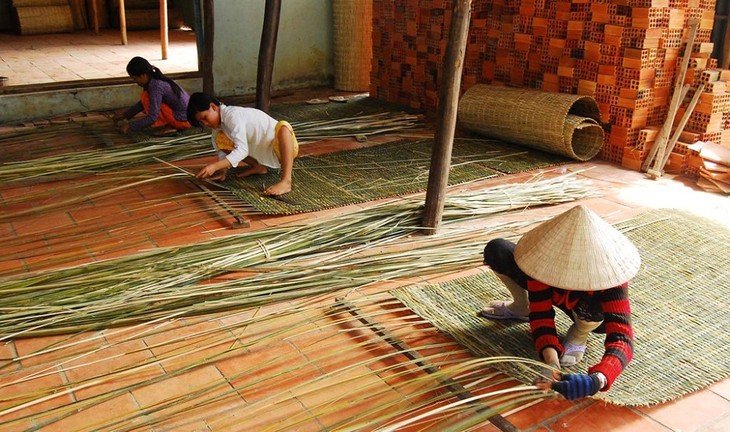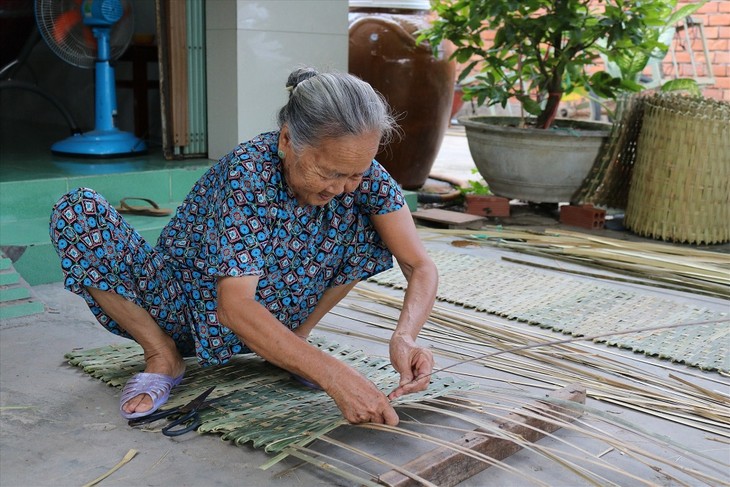(VOVWORLD) - “Mê bồ” or bamboo weaving is a traditional craft in My Tra commune, Cao Lanh city, Dong Thap province. A revival of “mê bồ” in recent years has improved the living conditions of those who still practice the age-old craft.
 It’s not difficult to weave bamboo panels, but it takes time! (Photo: vovgiaothong.vn) It’s not difficult to weave bamboo panels, but it takes time! (Photo: vovgiaothong.vn) |
“Mê bồ” refers to handcrafted products made of bamboo, reed, or rattan, which is split into long strips to be woven into large panels, which are used to hold rice, to make house walls, to cover floors of ships or barges. Many panels are sold to Cambodia for storing rice or drying fruits.
In the 100-year-old me bo craft village of My Tra, a villager can produce 8 to 10 panels of either large or small sizes a day, earning about 60 cents per panel. This work is what allows elderly people to cover their living expenses as two of them said:
“I'm old, so no one will hire me. I can't do heavy work. But weaving bamboo panels is easy.”
“It’s impossible for me to work for someone or be hired by a company. Whenever I'm free and feeling up to it, I do this work.”
80-year-old Nguyen Van Mo of My Tra commune has been engaged in the craft for 70 years. Seven of his eight children, like him, are weavers. Although the craft had eventually started to fade, his family has kept at it.
“Almost every villager weaves bamboo panels for supplementary income. Weaving manually, you can’t earn much, so we now use machines. My husband and I now earn about 5.6 USD per day after deducting all expenses. Using the machines makes the work much easier,” said Mo.
It’s not difficult to weave bamboo panels, but it takes time because the process is elaborate. People divide up the tasks. Men in good health split the bamboo. Women weave the panels. The bamboo must be soaked in water for half a day before being split into strips. Then it’s dried for a day to make it easier to split into thinner strips.
 On average a bamboo panel weaver earns between 3.2 and 5.6 USD per day. (Photo: laodong.vn) On average a bamboo panel weaver earns between 3.2 and 5.6 USD per day. (Photo: laodong.vn) |
The most difficult task is splitting strips from the outer bamboo shell. Those strips are used to weave first-class bamboo panels, which are more expensive than panels made from the bamboo strips split from the bamboo core. Those panels are cheaper because they’re less durable.
A bamboo panel weaver earns between 3.2 and 5.6 USD per day. Le Thi Phien’s family has escaped poverty by doing many different jobs, including weaving bamboo panels.
Phien told VOV, “My parents were making a living from this job. I followed them and as time went by I became more keen on it. When I became an adult with my own family, I started hiring myself out as a rice harvester during the harvest season. When the harvest is over, I do weaving. With my experience, I can weave any kind of panel.”
In the past, the craft made lots of local families well-off because panels to make rice bins, walls, and doors were in great demand. Bamboo panels are once again in demand for construction projects and for drying fruits ahead of the Lunar New Year season.
More than 170 households in My Tra commune and 20 in My Phu ward are engaged in the craft.
According to Vo Van Tho, who has been weaving bamboo panels for 30 years, “This craft can be a person’s main job. The panels sell well. If a road surface is damaged, people will buy a few dozen panels and mix soil into them to patch the road.”
The Dong Thap provincial People's Committee officially recognized My Tra commune as a traditional craft village in 2003. My Tra’s bamboo panels are much sought after in An Giang, Kien Giang, and Tien Giang province and are exported to Cambodia.